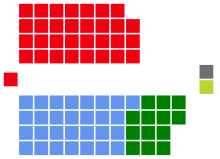1928 Australian federal election
| ||||||||||||||||||||||||||||||||||||||||||||||||||||||||||||||||||||||||||
All 76[b] seats in the House of Representatives 38 seats were needed for a majority in the House 19 (of the 36) seats in the Senate | ||||||||||||||||||||||||||||||||||||||||||||||||||||||||||||||||||||||||||
|---|---|---|---|---|---|---|---|---|---|---|---|---|---|---|---|---|---|---|---|---|---|---|---|---|---|---|---|---|---|---|---|---|---|---|---|---|---|---|---|---|---|---|---|---|---|---|---|---|---|---|---|---|---|---|---|---|---|---|---|---|---|---|---|---|---|---|---|---|---|---|---|---|---|---|
| Registered | 3,444,769 | |||||||||||||||||||||||||||||||||||||||||||||||||||||||||||||||||||||||||
| Turnout | 2,728,815 (93.64%)[a] ( | |||||||||||||||||||||||||||||||||||||||||||||||||||||||||||||||||||||||||
| ||||||||||||||||||||||||||||||||||||||||||||||||||||||||||||||||||||||||||
 Results by division for the House of Representatives, shaded by winning party's margin of victory. | ||||||||||||||||||||||||||||||||||||||||||||||||||||||||||||||||||||||||||
| ||||||||||||||||||||||||||||||||||||||||||||||||||||||||||||||||||||||||||
The 1928 Australian federal election was held in Australia on 17 November 1928. All 75 seats in the House of Representatives and 19 of the 36 seats in the Senate were up for election. The incumbent Nationalist–Country coalition, led by Prime Minister Stanley Bruce won a record fifth consecutive election defeating the opposition Labor Party led by James Scullin.
The election was held in conjunction with a referendum on Commonwealth–State relations, which was carried.
Future Prime Ministers John Curtin and Ben Chifley both entered parliament at this election. Both then lost their seats in the 1931 election and did not re-enter parliament until 1934 and 1940 respectively.
Issues
In September 1928, federal treasurer Earle Page introduced the National Insurance Bill 1928 into the House of Representatives, which provided for the establishment of a National Insurance scheme inclusive of "sickness, old age, disability and maternity benefits, mainly paid for by compulsory contributions by workers and employers, along with smaller payments to parents of children under 16 and to orphans".[1] The bill failed to pass before the dissolution of the House, but the scheme was "strongly promoted" by the government during the election campaign.[2]
Results

House of Representatives
| Party | Votes | % | Swing | Seats | Change | ||
|---|---|---|---|---|---|---|---|
| Nationalist–Country coalition | 1,286,208 | 49.56 | –3.64 | 42 | –8 | ||
| Nationalist | 1,014,522 | 39.09 | –3.37 | 29 | –8 | ||
| Country | 271,686 | 10.47 | –0.27 | 13 | 0 | ||
| Labor | 1,158,505 | 44.64 | –0.40 | 32[c] | +8 | ||
| Country Progressive | 41,713 | 1.61 | +1.61 | 1 | +1 | ||
| Protestant Labor | 20,212 | 0.78 | +0.78 | 0 | 0 | ||
| Independents | 88,447 | 3.41 | +1.65 | 1 | –1 | ||
| Total | 2,595,085 | 76 | |||||
| Two-party-preferred (estimated) | |||||||
| Nationalist–Country coalition | Win | 51.60 | −2.20 | 42 | –8 | ||
| Labor | 48.40 | +2.20 | 31 | +8 | |||
- Notes
- Independent: William McWilliams (Franklin, Tas.).
- Twelve members were elected unopposed – three Labor, five Nationalist, and four Country.
Senate
| Party | Votes | % | Swing | Seats won | Seats held | Change | ||
|---|---|---|---|---|---|---|---|---|
| Nationalist–Country coalition | 1,466,323 | 50.46 | –4.35 | 12 | 29 | +1 | ||
| Nationalist | 1,141,405 | 39.28 | –6.07 | 10 | 24 | 0 | ||
| Country | 324,918 | 11.18 | +1.73 | 2 | 5 | +1 | ||
| Labor | 1,422,418 | 48.95 | +3.93 | 7 | 7 | –1 | ||
| Independents | 17,092 | 0.59 | +0.42 | 0 | 0 | 0 | ||
| Total | 2,905,833 | 19 | 36 | |||||
Seats changing hands
| Seat | Pre-1928 | Swing | Post-1928 | ||||||
|---|---|---|---|---|---|---|---|---|---|
| Party | Member | Margin | Margin | Member | Party | ||||
| Barton, NSW | Nationalist | Thomas Ley | 1.0 | 7.3 | 6.3 | James Tully | Labor | ||
| Boothby, SA | Nationalist | Jack Duncan-Hughes | 7.6 | 7.7 | 0.1 | John Price | Labor | ||
| Denison, Tas | Nationalist | John Gellibrand | 2.2 | 2.5 | 0.3 | Charles Culley | Labor | ||
| Franklin, Tas | Nationalist | Alfred Seabrook | N/A | 7.2 | 1.6 | William McWilliams | Independent | ||
| Fremantle, WA | Independent | William Watson | 8.1 | 1.2 | 2.1 | John Curtin | Labor | ||
| Herbert, Qld | Nationalist | Lewis Nott | 0.3 | 0.5 | 0.2 | George Martens | Labor | ||
| Indi, Vic | Country | Robert Cook | 6.7 | N/A | (Unopposed) | Paul Jones | Labor | ||
| Lang, NSW | Nationalist | Elliot Johnson | 5.9 | 9.4 | 3.5 | William Long | Labor | ||
| Macquarie, NSW | Nationalist | Arthur Manning | 1.3 | 6.2 | 4.9 | Ben Chifley | Labor | ||
| Wakefield, SA | Nationalist | Richard Foster | 14.8 | 24.4 | 9.6 | Maurice Collins | Country | ||
| Wilmot, Tas | Country | Llewellyn Atkinson | 7.0 | N/A | 4.6 | Llewellyn Atkinson | Nationalist | ||
- Members listed in italics did not contest their seat at this election.
In the Division of Indi, the sitting candidate Robert Cook lost his seat after forgetting to file nomination papers, resulting in Labor candidate Paul Jones winning the seat unopposed.
See also
- Candidates of the 1928 Australian federal election
- Members of the Australian House of Representatives, 1928–1929
- Members of the Australian Senate, 1929–1932
Notes
- ^ Turnout in contested seats
- ^ The Northern Territory had one seat, but members for the territories did not have full voting rights until 1966 and did not count toward government formation.
- ^ Including Northern Territory
References
- ^ Wilks, Stephen (2020). 'Now is the Psychological Moment': Earle Page and the Imagining of Australia (PDF). ANU Press. p. 175. ISBN 9781760463687.
- ^ Wilks 2020, p. 176.
External links
- University of WA Archived 18 January 2015 at the Wayback Machine election results in Australia since 1890
- Two-party-preferred vote since 1919





